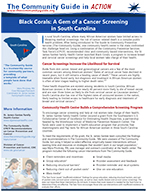Black Corals: A Gem of Cancer Screening Program in South Carolina
Summary
 In rural South Carolina the risk of cancer-related death is a complex public health problem. The St. James-Santee Family Health Center launched Black Corals to increase cancer screening among women. The Community Guide served as a resource to help the Black Corals program dramatically increase breast and cervical cancer screenings in their community. (Released 2012)
In rural South Carolina the risk of cancer-related death is a complex public health problem. The St. James-Santee Family Health Center launched Black Corals to increase cancer screening among women. The Community Guide served as a resource to help the Black Corals program dramatically increase breast and cervical cancer screenings in their community. (Released 2012)Lessons Learned
- Empower your community. Embrace community and partner involvement to create change and sustainability. No intervention will be successful if the community doesn’t feel able to address the issue. Using culturally appropriate messages of personal value and self-worth helped the Black Corals program reach and engage their target audience.
- Help secure funding by using evidence-based interventions. Although the grant awarded to St. James-Santee Family Health Center required use of The Community Guide, referencing it in other grant applications shows potential funders that your plans are based on proven strategies.
- Target interventions. Findings and recommendations in The Community Guide provide a framework to help design community-based programs. Program coordinators should consider the needs of the population and availability of local resources as they plan.
Story
 In rural South Carolina, where many African American women have limited access to lifesaving medical screenings, the risk of cancer-related death is a complex public health problem. After being introduced to The Guide to Community Preventive Services (The Community Guide), one community health center in the state confronted this challenge head on. Using a combination of the Community Preventive Services Task Force’s (Task Force) recommended clinic and community-based interventions, the St. James-Santee Family Health Center launched Black Corals, a program to increase breast and cervical cancer screenings and help local women take charge of their health.
In rural South Carolina, where many African American women have limited access to lifesaving medical screenings, the risk of cancer-related death is a complex public health problem. After being introduced to The Guide to Community Preventive Services (The Community Guide), one community health center in the state confronted this challenge head on. Using a combination of the Community Preventive Services Task Force’s (Task Force) recommended clinic and community-based interventions, the St. James-Santee Family Health Center launched Black Corals, a program to increase breast and cervical cancer screenings and help local women take charge of their health.
Cancer Screenings Increase the Likelihood for Survival
Aside from skin cancer, breast and gynecological cancers are a few of the most common cancers among American women.1 Rates of cervical cancer have declined in recent years, but it still remains a leading cause of death.2 These cancers are highly treatable when found early, but diagnosis and treatment in African American women is often at later stages leading to higher death rates.3,4
These health disparities are evident among residents in South Carolina. African American women in the state are nearly 40 percent more likely to die of breast cancer, and are over three times as likely to die from cervical cancer as Caucasian women.5 South Carolina also has one of the highest rates of uninsured women in the nation, likely leading to limited access to healthcare for early diagnosis and treatment of breast and cervical cancers.5
Community Health Center Builds a Comprehensive Screening Program
To encourage cancer screening and help at-risk women take charge of their health, St. James-Santee Family Health Center secured a grant from the Southeastern U.S. Collaborative Center of Excellence for Eliminating Health Disparities, a partnership headed by the Morehouse School of Medicine Prevention Research Center. The funds were used to implement a health education program that promotes free mammograms and Pap tests for African American women in three South Carolina counties.
To meet the requirements of the grant, the St. James-Santee team consulted the findings and recommendations in The Community Guide. “We were unaware of The Community Guide, but using it helped us select effective, empirically-based interventions without wasting time and resources on strategies that wouldn’t work in our target population,” says Myra Pinckney, RN, case manager and outreach coordinator at the health center. The program included the following cancer interventions from The Community Guide:
- Client reminders (breast, cervical)
- Client incentives (breast*, cervical*)
- Group education (breast, cervical*)
- Reducing structural barriers (breast, cervical*)
- Reducing client out-of-pocket costs (breast, cervical*)
- Mass media (breast*, cervical*)
- Small media (breast, cervical)
- Provider assessment and feedback (breast, cervical)
- Provider reminder and recall systems (breast, cervical)
- One-on-one education (breast, cervical)
Community Involvement Empowers Local Women
The health center packaged their program as the Black Corals project to engage the community and empower women to make personal health a priority. The program handed out black coral bracelets that included an insert with a positive message to African American women about self-worth and a reminder about breast and cervical cancer screening. Nurses and case managers traveled to local churches in the counties to hand out bracelets, lead workshops about risks and symptoms of breast and cervical cancers, and teach women about early detection.
An accompanying media campaign to spread the word about free exams available at the health center included posters at community events and flyers at hair salons. A local women’s church group spread the word through walks and cookouts about Black Corals and the health center’s screening programs. As more requests for screening appointments and education sessions came in, the health center worked with local restaurants and community partners to provide additional locations for educational workshops. The Medical University of South Carolina provided additional screening locations through its Hollings Cancer Center mobile mammography unit.
Community-Wide Behavior Change in the Wake of Black Corals
Within two years of putting Black Corals into action, the number of women at all four of the health center’s locations getting Pap tests increased by nearly 17 percent, mammograms increased by 15 percent, and the number of women who missed scheduled screening appointments dropped from 31 to 19 percent. Just as important, community involvement stayed strong with increased attendance at the educational workshops. “The results exceeded our initial expectations,” says Ms. Pinckney. “While reminder postcards were used, it was really the personal calls, flyers, education, and community enthusiasm that created a successful program.” The health center’s success prompted an invitation to join a local collaboration on cancer awareness and advocacy.
The St. James-Santee team now uses Black Corals as a model for other community-based programs. The health center has become a champion for The Community Guide and is using other Task Force findings and recommendations to push for new policies in their primary care and diabetes programs.
The Black Corals project won first place in the Public Health Foundation’s 2011 “I’m Your Community Guide!” contest, which highlighted groups that used Task Force findings and recommendations in The Community Guide to improve health in their communities.
*The Task Force issued “insufficient evidence” findings for some reviews. This does not mean that these interventions do not work. It means that more research is needed for the Task Force to determine if they are effective. The Task Force encourages those who use interventions with insufficient evidence to evaluate their efforts.
1 Centers for Disease Control and Prevention. Top 10 Cancers Among Women. www.cdc.gov/Features/dsWomenTop10Cancers. Accessed on March 20, 2012.
2 Centers for Disease Control and Prevention. Cervical Cancer Statistics. www.cdc.gov/cancer/cervical/statistics. Accessed on March 20, 2012.
3 Centers for Disease Control and Prevention. Cervical Cancer Rates by Race and Ethnicity. www.cdc.gov/cancer/cervical/statistics/race.htm. Accessed on March 20, 2012.
4 Centers for Disease Control and Prevention. African American Women and Mass Media Campaign. www.cdc.gov/cancer/healthdisparities/what_cdc_is_doing/aamm.htmwww.cdc.gov/cancer/healthdisparities/what_cdc_is_doing/aamm.htm. Accessed on March 20, 2012.
5 South Carolina Department of Health and Environmental Control. Cancer Statistics. www.scdhec.gov/health/chcdp/cancer/facts.htm. Accessed on March 20, 2012